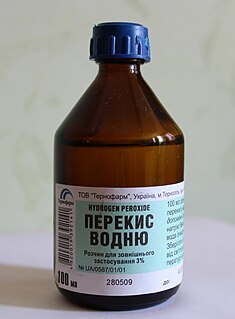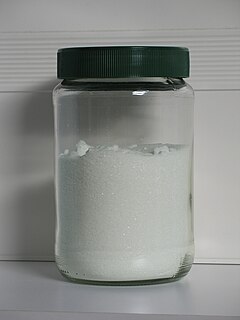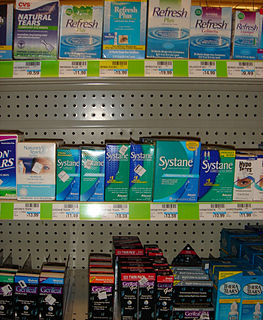
Hydrogen peroxide contact solutions are storage solutions for contact lenses that rely on hydrogen peroxide to clean the contacts and break up proteins and deposits during the disinfection process.

Hydrogen peroxide contact solutions are storage solutions for contact lenses that rely on hydrogen peroxide to clean the contacts and break up proteins and deposits during the disinfection process.
The majority of hydrogen peroxide solutions are 3% hydrogen peroxide. [1] This enables the solution to break down any proteins that coat the contacts after a long period of use. Hydrogen peroxide is always used alongside a neutralizing product. [2] The intention is to prevent the hydrogen peroxide from contact with the eye, which could damage the corneal cells in the epithelium. While this would not result in permanent damage, it can cause an intense burn that can linger even after an eye rinse. Burned cells heal very quickly once the natural tear film is restored. [3]
In order to prevent eye damage, the solution must undergo a chemical reaction before the contacts are placed into the individual's eyes. The contacts are placed into a special container with a platinum-coated disk, which reacts with the hydrogen peroxide. This “redox” reaction (reduction and oxidation) produces small bubbles that help to clean the contacts. After 6-8 hours, the hydrogen peroxide becomes an eye-safe saline solution. [4] At this point, it is safe to use the contact lenses. After extended use, the platinum coated disk must be replaced.
Both hydrogen peroxide and multipurpose solutions remove debris and build-up. Significant differences exist between the two. Hydrogen peroxide has the ability to penetrate microbial films, which helps create a deeper clean. Hydrogen peroxide solutions do not contain preservatives. [5] This can be beneficial for people who are allergic or sensitive to the preservatives in multipurpose solutions. Hydrogen peroxide solutions have a greater ability to fight acanthamoeba keratitis, a rare infection that can cause blindness. Some researchers have found the peroxide cleaning regimen to encourage better contact lens care practices among peroxide users compared to multipurpose solution users. [6]
Multipurpose solutions tend to be less expensive. [7] Contacts do not have to be placed in multipurpose solutions for extended intervals, whereas contacts must be left in a hydrogen peroxide solution for hours. The main attraction of multipurpose solutions is that the same solution can clean, rinse, disinfect and store lenses. [8] Hydrogen peroxide solutions require a separate solution in order to rinse the contacts. Procedural mistakes put eyes at risk from contacting the hydrogen peroxide.
Most hydrogen peroxide solutions cost around ten to twenty dollars. Three main name brands are available along with several generic products. The original brands were Softmate, Mirasept, Lensept, Oxysept I/II, IN a wink, and AOSept. Clear Care, the current evolution of the old AOsept system, is said to count for more than 80 percent of the hydrogen peroxide systems sold in the US. [3] Clear Care contains a poloxamine derivative surfactant that helps loosen debris and deposits via a bubbling action and has a platinum disk that neutralizes the solution and is good for up to 100 uses. Prior to Clear Care, the market only provided a two step system where you first soaked the lenses in peroxide for a short period of time or overnight then replaced it with a neutralizing saline. These systems used a catalyse enzyme in saline form and was preserved. The AOSept system made by American Optical was the peroxide solution uses a disk to neutralize the solution. The Lensept system was also similar and used two different cups, one contained the disc and the other was for soaking. Oxysept and Omnicare was slightly different from the other two brands in that it uses tablets for the neutralization effect, which causes a slower process. The result of the tablets is a longer exposure to more concentrated hydrogen peroxide. Following recommendations to add an enzymatic cleaner weekly, increases costs. [3]

Hydrogen peroxide is a chemical compound with the formula H
2O
2. In its pure form, it is a very pale blue liquid, slightly more viscous than water. It is used as an oxidizer, bleaching agent, and antiseptic, usually as a dilute solution in water for consumer use, and in higher concentrations for industrial use. Concentrated hydrogen peroxide, or "high-test peroxide", decomposes explosively when heated and has been used as a propellant in rocketry.

Contact lenses, or simply contacts, are thin lenses placed directly on the surface of the eyes. Contact lenses are ocular prosthetic devices used by over 150 million people worldwide, and they can be worn to correct vision or for cosmetic or therapeutic reasons. In 2010, the worldwide market for contact lenses was estimated at $6.1 billion, while the US soft lens market was estimated at $2.1 billion. Multiple analysts estimated that the global market for contact lenses would reach $11.7 billion by 2015. As of 2010, the average age of contact lens wearers globally was 31 years old, and two-thirds of wearers were female.
A drain cleaner is a chemical product that unblocks sewer pipes or clogged wastewater drains. The term may also refer to a mechanical device such as a plumber's snake, drain auger, toilet plunger, or similar device. Occasionally, the term is applied to a plumber or other individual who performs the drain cleaning and hygiene.

A disinfectant is a chemical substance or compound used to inactivate or destroy microorganisms on inert surfaces. Disinfection does not necessarily kill all microorganisms, especially resistant bacterial spores; it is less effective than sterilization, which is an extreme physical or chemical process that kills all types of life. Disinfectants are generally distinguished from other antimicrobial agents such as antibiotics, which destroy microorganisms within the body, and antiseptics, which destroy microorganisms on living tissue. Disinfectants are also different from biocides—the latter are intended to destroy all forms of life, not just microorganisms. Disinfectants work by destroying the cell wall of microbes or interfering with their metabolism. It is also a form of decontamination, and can be defined as the process whereby physical or chemical methods are used to reduce the amount of pathogenic microorganisms on a surface.

Benzalkonium chloride, also known as alkyldimethylbenzylammonium chloride (ADBAC) and by the trade name Zephiran, is a type of cationic surfactant. It is an organic salt classified as a quaternary ammonium compound. ADBACs have three main categories of use: as a biocide, a cationic surfactant, and a phase transfer agent. ADBACs are a mixture of alkylbenzyldimethylammonium chlorides, in which the alkyl group has various even-numbered alkyl chain lengths.

Chlorhexidine (CHX) is a disinfectant and antiseptic that is used for skin disinfection before surgery and to sterilize surgical instruments. It may be used both to disinfect the skin of the patient and the hands of the healthcare providers. It is also used for cleaning wounds, preventing dental plaque, treating yeast infections of the mouth, and to keep urinary catheters from blocking. It is used as a liquid or powder.
Jewelry cleaning is the practice of removing dirt or tarnish from jewelry to improve its appearance.
ReNu is a brand of soft contact lens care products produced by Bausch & Lomb. By far the most popular brand of lens solutions until 2006, ReNu has rebranded its formulations as renu sensitive and renu fresh, the latter containing a patented ingredient called hydranate, known by chemists as hydroxyalkylphosphonate, that removes protein deposits and can eliminate the need for a separate enzymatic cleaner.

Sodium chlorite (NaClO2) is a chemical compound used in the manufacturing of paper and as a disinfectant.

Artificial tears are lubricating eye drops used to relieve dryness and irritation of the ocular surface. Dry eye syndrome is a common ocular surface disorder and is characterized by disruption of the tear film and increased inflammation.

Piranha solution, also known as piranha etch, is a mixture of sulfuric acid and hydrogen peroxide, used to clean organic residues off substrates. Because the mixture is a strong oxidizing agent, it will decompose most organic matter, and it will also hydroxylate most surfaces, making them highly hydrophilic (water-compatible). This means the solution can also easily dissolve fabric and skin, potentially causing severe damage and chemical burns in case of inadvertent contact.
Infection prevention and control is the discipline concerned with preventing healthcare-infections; a practical rather than academic sub-discipline of epidemiology. In Northern Europe, infection prevention and control is expanded from healthcare into a component in public health, known as "infection protection". It is an essential part of the infrastructure of health care. Infection control and hospital epidemiology are akin to public health practice, practiced within the confines of a particular health-care delivery system rather than directed at society as a whole.

Lysol is a brand of American cleaning and disinfecting products distributed by Reckitt, which markets the similar Dettol or Sagrotan in other markets. The line includes liquid solutions for hard and soft surfaces, air treatment, and hand washing. The active ingredient in many Lysol products is benzalkonium chloride, but the active ingredient in the Lysol "Power and Free" line is hydrogen peroxide. Lysol has been used since its invention in the late 19th century as a household and industrial cleaning agent, and previously as a medical disinfectant.
Johnson & Johnson Vision (JJV) is a subsidiary of Johnson & Johnson and is composed of two divisions, Johnson & Johnson Surgical Vision and Johnson & Johnson Vision Care. Services include Intraocular lenses, laser vision correction systems, phacoemulsification systems, viscoelastic, Microkeratomes and related products used in cataract and refractive surgery.

Polyaminopropyl biguanide (PAPB) is a disinfectant and a preservative used for disinfection on skin and in cleaning solutions for contact lenses. It is also an ingredient in many deodorant bodysprays. It is a polymer or oligomer where biguanide functional groups are connected by propyl hydrocarbon chains. PAPB is specifically bactericidal at very low concentrations (10 mg/l) and is also fungicidal.

Bleach is the generic name for any chemical product that is used industrially or domestically to remove color from a fabric or fiber or to clean or to remove stains in a process called bleaching. It often refers, specifically, to a dilute solution of sodium hypochlorite, also called "liquid bleach".

Cleaning agents or hard-surface cleaners are substances used to remove dirt, including dust, stains, bad smells, and clutter on surfaces. Purposes of cleaning agents include health, beauty, removing offensive odor, and avoiding the spread of dirt and contaminants to oneself and others. Some cleaning agents can kill bacteria and clean at the same time. Others, called degreasers, contain organic solvents to help dissolve oils and fats.
A rotating ring-disk electrode (RRDE) is a double working electrode used in hydrodynamic voltammetry, very similar to a rotating disk electrode (RDE). The electrode rotates during experiments inducing a flux of analyte to the electrode. This system used in electrochemical studies when investigating reaction mechanisms related to redox chemistry and other chemical phenomena.

Microbial corneal infection is the most serious and "most common vision threatening" complication of contact lens wear, which is believed to be strongly associated with contact lens cases. Such infections "are being increasingly recognized as an important cause of morbidity and blindness" and "may even be life-threatening." While the cornea is believed to be the most common site for fungal eye infections, other parts of the eye such as the orbit, sclera, eyelids, and more may also be involved. Contact lens cases are recognized as a "potential source of pathogens associated with corneal ulcers" and according to Moorfields Eye Hospital, contact lens wear is “the most prevalent risk factor for new cases of corneal ulcers.” Contaminants "isolated from contact lens associated corneal ulcers have often been shown to be" the same as found in the patient's contact lens case, thus providing evidence contaminated contact lens cases may be a "replenishable source of pathogenic microbes."
Accelerated hydrogen peroxide (AHP) is a solution of hydrogen peroxide whose antibacterial efficacy is enhanced by a surfactant and an organic acid. It is also a disinfectant/cleaning agent that stabilizes hydrogen peroxide so that it can be used for extended periods of time.